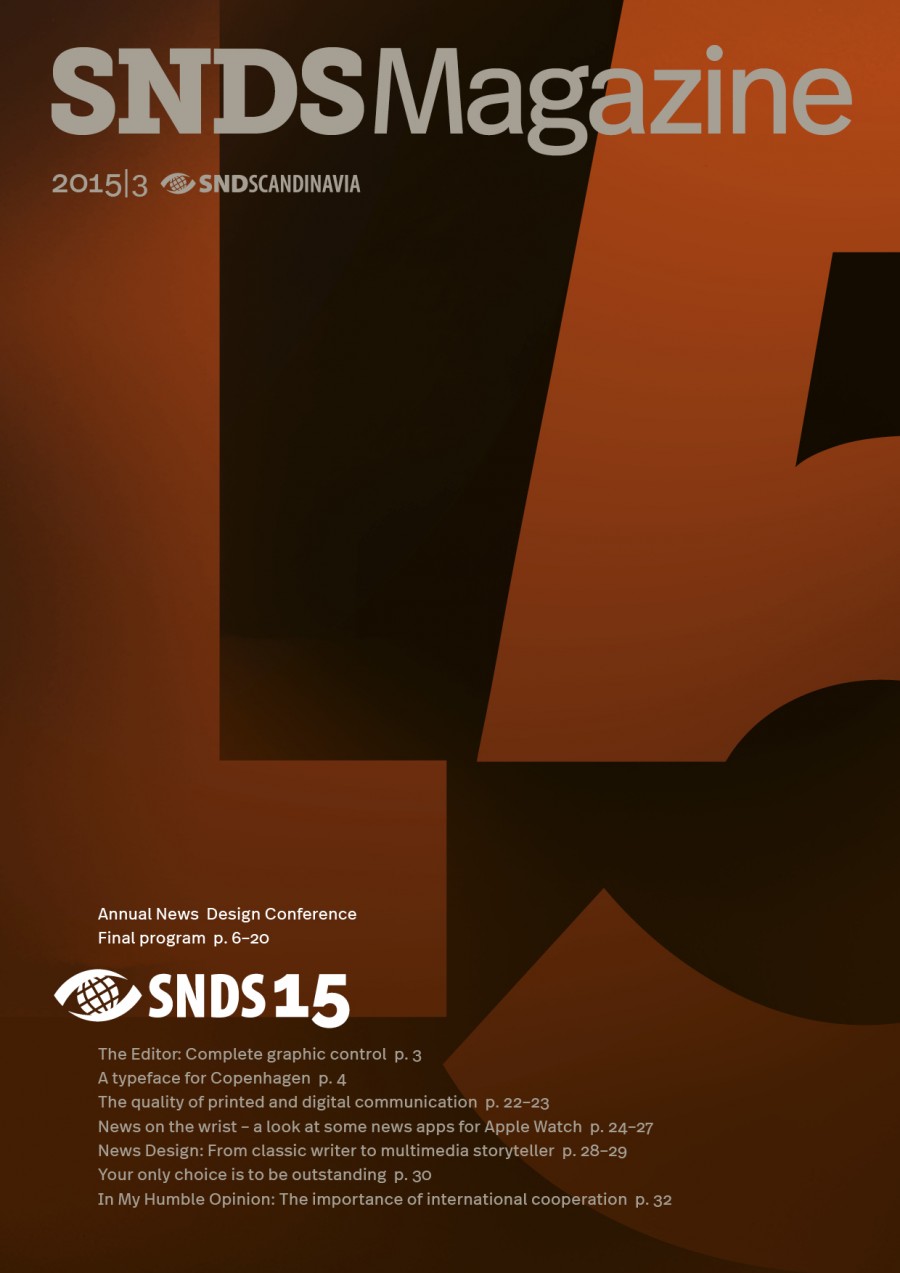Editorial, SNDS Magazine 3, September 2015
“Type design is […] the last arena where the graphic designer is still in charge of his or her own work.”
– Adrian Shaughnessy*
There was an uproar in the Danish media world – among graphic designers especially – when Egmont Publishing in August decided to outsource a series of layout tasks to a company as far away as Vietnam, cutting down in-house staff and pushing 13 designers out of their jobs. Upscale lifestyle magazine Euroman’s Editor-in-Chief resigned in protest and its leading Art Director was fired as a result of the decision. Social media exploded.
 Deciding where to have your pages designed involves the question of control, and one way of keeping control over long-distance work is by using templates. The most ‘important’ Euroman pages will still be designed at home, close to editors and writers, whereas the Vietnam-produced pages will rely heavily on templates.
Deciding where to have your pages designed involves the question of control, and one way of keeping control over long-distance work is by using templates. The most ‘important’ Euroman pages will still be designed at home, close to editors and writers, whereas the Vietnam-produced pages will rely heavily on templates.
“The challenge for designers – a group that increasingly includes thoughtful users as well as professional typographers – is to disable the stylistic limitations of templates”, Ellen and Julia Lupton wrote back in 2007**.
While the consensus among designers in the present debate seems to be that in-house designers are expected to do just that: thoughtfully break the stylistic limitations and create art – there is fear that Vietnamese designers on a budget will break the templates to create disasters.
We already know that Danish Art Directors are able to produce great work, but if the result of the outsourcing will be disastrous remains to be seen when the first issues of the ‘new’ Euroman hit the newsstands.
Type control
The unemployed designers now have to look elsewhere to work with the craft they love. Some may start their own company – they can turn to page 30 and our review of a new book that will guide their way.
Others may engage in type design – an area where, according to the opening quote above, it is actually possible to have if not complete then at least a high degree of control over your work.
In an article on Design Observer, London-based graphic designer and writer Adrian Shaughnessy asks the question, “How many typefaces is too many typefaces?” His answer is that there probably is no limit, one of the reasons being that young designers turn to type design as one of the last arenas of free expression – away from the “templated graphic environments where everything is already designed” and from the “slavish adherence to business strategies that limit creative thinking”.
Designing type is also about dealing strictly with form, it “feels like the exercise of a craft. It feels like proper old-fashioned ‘making’, at a time when huge areas of graphic design practice have become increasingly robotic”.
No templates, no interference from picky clients. Maybe that’s what urged three Danish designers to create a font for the City of Copenhagen – without actually having the City (or anyone else) as a client. The result was a font free for all to download (see p. 4).
Wearable screens
The Apple Watch, on the other hand, is no doubt the result of serious strategic thinking. Owning 75% of the smart watch market, Apple Watch is the place to be for news businesses in the future. Kim Bjørn, designer and co-founder of Cre8o, looks at some of the news apps that have already appeared on the wearable screen, including his own design for Ekstra Bladet (see p. 24–27).
Cooperation is key
Visuals were not always an integrated part of telling a news story – but cooperation between colleagues with different skills has become an important part of the whole picture. As Maj Ribergård’s interview with a classic-journalist-turned-visual-storyteller shows, journalists can gain a lot from incorporating visuals and graphic tools in the planning of articles (see p. 28–29).
Cooperation is also the subject for SNDS President Flemming Hvidtfeldt’s column on our back page. He reminds us that SNDS is part of the global organisation SND – which gives members the potential to reach far beyond the Scandinavian countries.
This international focus is also reflected in the line-up at the big event of the year in SNDS:
SNDS15 News Design Conference
We’re proud to devote the majority of this magazine to presenting the final program for two inspiring days in
Copenhagen. And there is still time to take a quick decision not to miss out: Check out the speakers and the program on page 6–18, then register online on conference.snds.org – or fill in the form on page 19-20.
See you in Copenhagen on 1–2 October!
Lars Pryds
Editor, SNDS Magazine
*In: Typographic Tipping Point, designobserver.com 07.06.2015
**In: Univers Strikes Back, 2007. Quoted from Graphic Design Theory : Readings From the Field. Princeton Architectural Press, 2009.
…